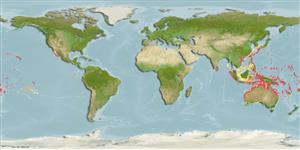Common names from other countries
Environment: milieu / climate zone / depth range / distribution range
Ecologia
marinhas associadas(os) a recifes; intervalo de profundidade 4 - 40 m (Ref. 90102), usually 27 - 30 m (Ref. 9710). Tropical
Western Pacific: southern Japan to the Great Barrier Reef, east to Pitcairn, west to Western Australia.
Tamanho / Peso / Idade
Maturity: Lm ? range ? - ? cm
Max length : 15.0 cm TL macho/indeterminado; (Ref. 48636)
Espinhos dorsais (total): 5; Raios dorsais moles (total): 21; Espinhos anais 1; Raios anais moles: 16 - 17. Recognized by the double lines of dashes over the back (Ref. 48636). Lower two-thirds of body whitish with 8 narrow red bars, each containing 2 dark spots (black or darker red), one at of bar and one at level of lower third of body. A small dark red to black spot on abdomen above base of pelvic fins. Spinous portion of dorsal fin cream with a broad oblique black bar (except posteriorly). Scales on opercle cycloid (Ref 42740).
Mainly occurs at moderate depth on open rubble reef flats, but occasionally more shallow on outer reef habitats (Ref. 48636). Usually on rubble or sand near coral reefs (Ref. 42740) solitary or forms small groups (Ref. 90102).
Life cycle and mating behavior
Maturidade | Reprodução | Desova | Ovos | Fecundidade | Larvas
Randall, J.E., G.R. Allen and R.C. Steene, 1990. Fishes of the Great Barrier Reef and Coral Sea. University of Hawaii Press, Honolulu, Hawaii. 506 p. (Ref. 2334)
Categoria na Lista Vermelha da IUCN (Ref. 130435)
CITES (Ref. 128078)
Not Evaluated
Ameaça para o homem
Harmless
Utilização humana
Pescarias: sem interesse
Mais informação
Nomes comunsSinónimosMetabolismoPredadoresEcotoxicologiaReproduçãoMaturidadeDesovaFecundidadeOvosDesenvolvimento dos ovos
ReferênciasAquaculturaPerfil para aquaculturaEstirpesGenéticaElectrophoresesHereditariedadeDoençasProcessamentoMass conversion
ColaboradoresFotografiasStamps, Coins Misc.SonsCiguateraVelocidadeTipo de nataçãoÁrea branquialOutras referênciasCérebrosVisão
Ferramentas
Relatórios especiais
Descarregue XML
Fontes da internet
Estimates based on models
Preferred temperature (Ref.
115969): 24.2 - 28.5, mean 26.9 (based on 46 cells).
Phylogenetic diversity index (Ref.
82804): PD
50 = 0.5000 [Uniqueness, from 0.5 = low to 2.0 = high].
Bayesian length-weight: a=0.00692 (0.00311 - 0.01538), b=3.06 (2.88 - 3.24), in cm Total Length, based on LWR estimates for this Genus-body shape (Ref.
93245).
Nível Trófico (Ref.
69278): 3.5 ±0.4 se; based on size and trophs of closest relatives
Resiliência (Ref.
120179): Elevada, tempo mínimo de duplicação da população menor que 15 meses (Preliminary K or Fecundity.).
Fishing Vulnerability (Ref.
59153): Low vulnerability (10 of 100).
